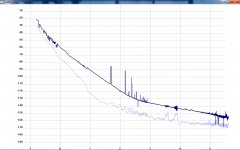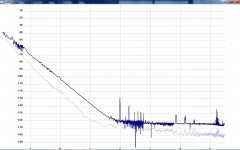Except Herbert Rutgers thinks like me and not like you.
Which of course is no proof of anything. The elephant in the room is that the air in a typical recording environment is not stationary (HVAC currents/random temp variations) to anywhere near these levels. This is a proven fact by measurement and it consists mainly of close in low frequency jitter.
Last edited:
Sorry, at this point I need to quote you from a few posts above:
"It's me who waste time with those who claims something but then do not know what he is talking about".
Next time try to understand what it is told and quoted, in particular numbers; when everything fails, you can always ask for help, usually a good soul will always try to educate you, although:
There is a subtle difference, I cannot demonstrate what others claimed before me and I agree, but I know what I'm talking about.
Indeed I'm trying to follow that way as best as possible, such as best oscillators, isolated time domains and so on.
but I know what I'm talking about.
No, you don't; you do not have the foggiest idea what -144dB SNR means.
Here's my last attempt to clue you: get a copy of this paper from the late 60's https://www.tandfonline.com/doi/abs/10.3109/05384916809074316?journalCode=iija18 (sorry, I don't have a copy at hand) and read through; you will find out that the brownian noise of air in an adiabatic room, determined as the average local pressure changes due to molecules collisions, is about -24dB SPL (the reference is the well known and documented human hearing threshold).
I'll leave the fun of estimating a rough comparison between the effect of the air molecules brownian motion (aka brown noise), and the effect of -144dB SNR (even with an ideal transducer, aka "speaker"), on your organic auditive system in your trustful hands, perhaps you'll realize how ridiculous is to infer anything audible around -144dB (or even -120dB; or even -100dB). I am not holding my breath, though, Upton Sinclair quote applies.
Last edited:
Which of course is no proof of anything. The elephant in the room is that the air in a typical recording environment is not stationary (HVAC currents/random temp variations) to anywhere near these levels. This is a proven fact by measurement and it consists mainly of close in low frequency jitter.
I cannot improve the recording environment, it's out of my reach.
But I can try to listen to the music at its best, so that a Steinway grand piano is such and not a Yamaha.
I thought it was clear that I have no technical or mathematical means to prove how the close in phase noise affects the sound quality.
It's my philosophical approach after several listening sessions and comparisons.
Every time I have improved the close in phase noise the sound quality has improved, even with worse noise floor.
So I agree that wideband jitter degrades the SNR, but the close in jitter has another kind of effect which we are not still able to explain and measure.
How can an FFT analyzer with far worse time base quality than the oscillator used in digital to analog conversion measure the noise spectrum at the DAC output?
Phase noise analyzer uses cross correlation to overcome this limit but we can't do this with a FFT analyzer because there is no zero crossing to detect in audio signal.
No, you don't; you do not have the foggiest idea what -144dB SNR means.
Here's my last attempt to clue you: get a copy of this paper from the late 60's https://www.tandfonline.com/doi/abs/10.3109/05384916809074316?journalCode=iija18 (sorry, I don't have a copy at hand) and read through; you will find out that the brownian noise of air in an adiabatic room, determined as the average local pressure changes due to molecules collisions, is about -24dB SPL (the reference is the well known and documented human hearing threshold).
I'll leave the fun of estimating a rough comparison between the effect of the air molecules brownian motion (aka brown noise), and the effect of -144dB SNR (even with an ideal transducer, aka "speaker"), on your organic auditive system in your trustful hands, perhaps you'll realize how ridiculous is to infer anything audible around -144dB (or even -120dB; or even -100dB). I am not holding my breath, though, Upton Sinclair quote applies.
No, you have not understood.
You continue converting the close in jitter in SNR.
You can do that for wideband jitter but not for close in jitter.
I have already said that a worse noise floor of the oscillators does not affect the sound, so your -144dB are useless because you are limiting your analysis to the wideband noise.
Doesn't look like certain people are getting the point that -140dB phase noise at 10Hz is one thing, but we are concerned from there down to .1Hz in an area of rapidly increasing low frequency noise.
There is already some discussion of possible consequences starting from: ESS Sabre Reference DAC (8-channel) (posts #2650 to #2656).
In addition, I have to agree its not hard to hear the beneficial effects of low phase noise clocks. Seems probable the reason nobody every does anything about it in consumer dacs is because it isn't cheap to fix. Although I have a pretty good solution with off the shelf ultra low jitter clocks, even that isn't cheap enough for low cost dac.
In any case, I intend to find out what lower phase noise clocks do to/for the sound, good or bad or nothing. I just want to know. Like Andrea, I don't care about back of envelope calculations. If it works, it works. Then the problem is to find out why, if we can. Maybe the explanation we discussing right now isn't the whole story. Don't know. No point arguing about a nascent theory we don't understand well enough yet.
There is already some discussion of possible consequences starting from: ESS Sabre Reference DAC (8-channel) (posts #2650 to #2656).
In addition, I have to agree its not hard to hear the beneficial effects of low phase noise clocks. Seems probable the reason nobody every does anything about it in consumer dacs is because it isn't cheap to fix. Although I have a pretty good solution with off the shelf ultra low jitter clocks, even that isn't cheap enough for low cost dac.
In any case, I intend to find out what lower phase noise clocks do to/for the sound, good or bad or nothing. I just want to know. Like Andrea, I don't care about back of envelope calculations. If it works, it works. Then the problem is to find out why, if we can. Maybe the explanation we discussing right now isn't the whole story. Don't know. No point arguing about a nascent theory we don't understand well enough yet.
Last edited:
No, you don't; you do not have the foggiest idea what -144dB SNR means.
I thought il Sig. Rutgers was clear about it. Who the hell keeps talking about - 144dB noise floor.
I had brought up earlier too. Close in fluctuation levels are enormous. How high is your clock speed in your dac (ESS?) 100MHz?
Here it is a graph taken by me, of a Crystek CCHD 45MHz XO. The graph starts at 10^-1 Hz, that is, 0,1Hz.
At that range, it's -15dBc the fluctuation.
Attachments
Last edited:
Wow. Just wow.
Unbelievable indeed. All kind of religious and political resemblances come to mind, but I'll hold them, for obvious reasons.
The main reason I am always suspecting some hidden agenda behind certain characters stances is that I cannot believe somebody, with a reasonable level of education, can be, in good faith, that opaque to any healthy reasoning. I'd rather like to be wrong in this, but never got any counterexample so far.
Here it is a graph taken by me, of a Crystek CCHD 45MHz XO. The graph starts at 10^-1 Hz, that is, 0,1Hz.
At that range, it's -15dBc the fluctuation.
And I'm sure that is audible, isn't it? What about 0.01Hz, or 0.001Hz? I was once able to measure a resistor noise down to 1 microHertz. Took about a week, noise density is huge, but I can vouch the 1/f noise is still valid, physics was saved. However this led me to the conclusion that for audio the best resistor is no resistor.
Game over.
the Gang of (more than) Four
 Fitting, given the constant factional infighting. Pity we can't have the show trials too.
Fitting, given the constant factional infighting. Pity we can't have the show trials too.Any chance of trying to conduct some blind tests with different clocks?
With a well controlled test a single pass from someone is almost undeniable proof, while a single fail proves almost nothing, really it is the greatest tool in proving the audibility of something, even though it often used to argue the opposite.
Setting up a test like this would be very awkward but it would go a long way.
With a well controlled test a single pass from someone is almost undeniable proof, while a single fail proves almost nothing, really it is the greatest tool in proving the audibility of something, even though it often used to argue the opposite.
Setting up a test like this would be very awkward but it would go a long way.
Nothing to do with unfounded beliefs. Some of us already know from countless experiments and countless listening tests (some sighted, some not): Ultra low phase noise clocks do something to improve sound reproduction in otherwise very high quality reproduction systems. Its no longer an open question for us.
If someone then comes along and says, "my calculations show your claim is impossible." Then my attitude is that something is wrong with your calculation or your assumptions.
You may as well produce a calculation that says, "man will never fly, its physically impossible." In other words, its too late. We already know about airplanes. And some of us already know about low phase noise in clocks. Happy to show interested individuals who are willing to visit Auburn when COVID is over. I can even demo 3-day clock warm up. Using already warmed up reference clocks allows for quick A/B comparisons with clocks still in the process of warming up. Means staying in Auburn 3-days though...
If someone then comes along and says, "my calculations show your claim is impossible." Then my attitude is that something is wrong with your calculation or your assumptions.
You may as well produce a calculation that says, "man will never fly, its physically impossible." In other words, its too late. We already know about airplanes. And some of us already know about low phase noise in clocks. Happy to show interested individuals who are willing to visit Auburn when COVID is over. I can even demo 3-day clock warm up. Using already warmed up reference clocks allows for quick A/B comparisons with clocks still in the process of warming up. Means staying in Auburn 3-days though...
Last edited:
Can somebody explain the significance of this in terms that even a simpleton, who thinks 3% THD is a bit much, can understand?
No.
You don't know anything, zero, about it's audibility.
Do you? Look ma, your Markw4 peer seem to know. No data, of course, only the "trust me, I know" mantra. Flashnews, I choose not to.
- Home
- Source & Line
- Digital Line Level
- AK4499EQ - Best DAC ever

